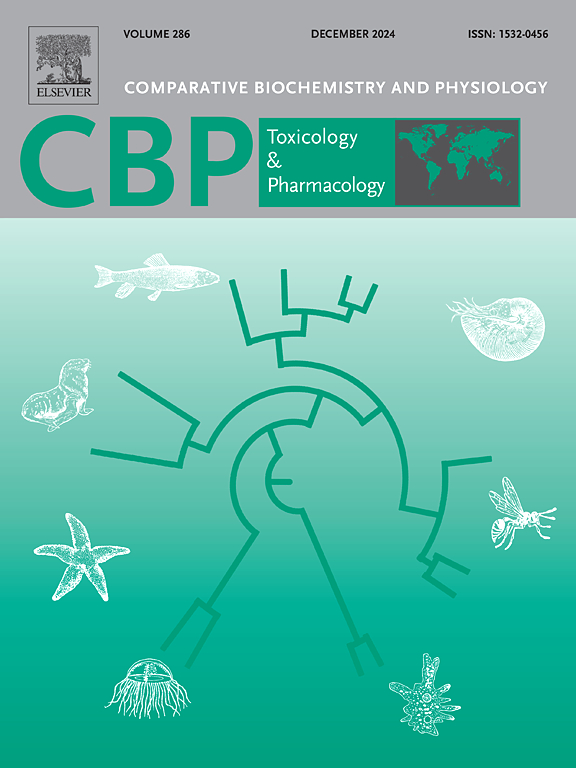New insights into the cytotoxic mechanism of marine-fungus-derived citrinin in three-dimensional Hepa1-6 cell model
IF 3.9
3区 环境科学与生态学
Q2 BIOCHEMISTRY & MOLECULAR BIOLOGY
Comparative Biochemistry and Physiology C-toxicology & Pharmacology
Pub Date : 2025-03-29
DOI:10.1016/j.cbpc.2025.110196
引用次数: 0
Abstract
Although recent studies have demonstrated that Marine-fungus-derived citrinin (MFDC) has a significant cytotoxic effect in traditional two-dimensional (2D) monolayer cell culture and animal models, its precise cytotoxic mechanism, particularly in a three-dimensional (3D) cell culture model remains unclear. In this study, a 3D Hepa1-6 cell model based on Matrigel was used to investigate the potential cytotoxic mechanism of MFDC (0–100 μg/mL). The results revealed that, after treatment of 60–100 μg/mL MFDC, the increases of reactive oxygen species (ROS), lactate dehydrogenase (LDH), aspartate aminotransferase (AST) and alanine aminotransferase (ALT) in 2D cell model were more significant than those in 3D cell model. In addition, the metabolomic results revealed that the significantly altered metabolic pathways were pyrimidine metabolism and vitamin B6 metabolism, which might be related to the interference of MFDC in the pyrimidine synthesis pathway, as well as the upregulation of pyridoxine 5'phosphate oxidase and pyridoxal kinase activities. This study was the first to compare the cytotoxicology of 2D and Matrigel-based 3D cell models after MFDC induction, and to detect differences in cell metabolites after MFDC induction in 3D cell models, providing a new scientific basis for the use of a 3D cell model and a novel research idea for the cellular damage caused by MFDC.

三维Hepa1-6细胞模型中海洋真菌衍生的柑橘霉素细胞毒性机制的新见解
虽然最近的研究表明,海洋真菌衍生的柑桔素(MFDC)在传统的二维(2D)单层细胞培养和动物模型中具有显著的细胞毒性作用,但其确切的细胞毒性机制,特别是在三维(3D)细胞培养模型中仍不清楚。本研究采用基于Matrigel的Hepa1-6三维细胞模型,探讨MFDC (0 ~ 100 μg/mL)的潜在细胞毒性机制。结果显示,60 ~ 100 μg/mL MFDC处理后,2D细胞模型中活性氧(ROS)、乳酸脱氢酶(LDH)、天冬氨酸转氨酶(AST)和丙氨酸转氨酶(ALT)的升高明显高于3D细胞模型;此外,代谢组学结果显示,显著改变的代谢途径是嘧啶代谢和维生素B6代谢,这可能与MFDC对嘧啶合成途径的干扰以及吡哆醇5′磷酸氧化酶和吡哆醇激酶活性的上调有关。本研究首次比较了MFDC诱导后2D和基于matrigel的3D细胞模型的细胞毒理学,并检测了3D细胞模型中MFDC诱导后细胞代谢物的差异,为3D细胞模型的使用提供了新的科学依据,为MFDC引起的细胞损伤提供了新的研究思路。
本文章由计算机程序翻译,如有差异,请以英文原文为准。
求助全文
约1分钟内获得全文
求助全文
来源期刊
CiteScore
7.50
自引率
5.10%
发文量
206
审稿时长
30 days
期刊介绍:
Part C: Toxicology and Pharmacology. This journal is concerned with chemical and drug action at different levels of organization, biotransformation of xenobiotics, mechanisms of toxicity, including reactive oxygen species and carcinogenesis, endocrine disruptors, natural products chemistry, and signal transduction with a molecular approach to these fields.

 求助内容:
求助内容: 应助结果提醒方式:
应助结果提醒方式:


